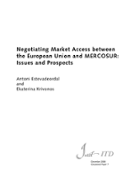Negotiating Market Access between the European Union and MERCOSUR: Issues and Prospects
Date
Dec 2000
EDITOR
INTAL
The European Union (EU) and MERCOSUR are the largest and most influential regions, both by population and in terms of size of the economy, of their respective continents. The renewed priority given to biregional cooperation launched by the Inter-Regional Framework Agreement signed in 1995 is based on deep historical, political, economic and cultural links between the two regions. The potential advantages of an agreement that will foster a process of dynamic cooperation are enormous, ranging from political influence to economic returns, including the gains from comparative advantage, expanding markets, improved environment for investments, and positive spillovers on human and social capital, democracy, and justice. A free trade agreement between the two regions should also be evaluated in the context of the new regionalism initiatives taking place around the world, in particular the Free Trade Area of the Americas (FTAA) negotiations and the process of enlargement and deepening of the two regional blocs. The objective of this paper is to offer an X-ray of the current status of existing market access provisions both in MERCOSUR and the EU. This is an important and necessary first step to identify the key issues facing market access negotiators from the very outset of the negotiations. As has already been agreed during the first meeting of the European Union - Mercosur Biregional Negotiations Committee, one of the first tasks of the Technical Group charged with market access issues will be the exchange of information in the areas of tariff and non-tariff measures. This initial exchange of information among negotiating parties usually plays a key role in the overall formulation of each party's negotiating strategy. This paper attempts, using mostly secondary sources and data compiled by international agencies, to take a seat at the negotiating table and provide the best snapshot possible of the situation. In this regard, it is important to stress that the information used and analyzed in this paper should not be taken in any way as the official picture of the market access profiles of each region.




